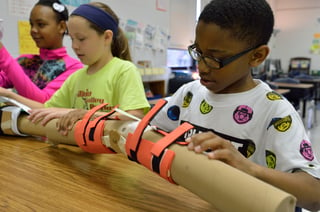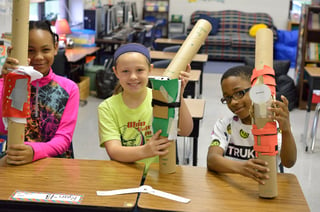 Any teacher will tell you that getting students to work together effectively in teams is not easy. Simply telling students to work together won’t lead to productive collaboration. The term “collaboration” has many definitions, but most writers agree it’s more than just working in a group. Collaboration is the act of engaging in creative group work that sparks innovation and productivity. To accomplish this, teachers need to model productive collaboration and give students authentic opportunities to collaborate. Of course, this is always easier said than done. Because EiE values collaboration and views collaboration as an essential part of engineering (and of life), we developed curricula that models for teachers easy and effective ways to encourage productive collaboration.
Any teacher will tell you that getting students to work together effectively in teams is not easy. Simply telling students to work together won’t lead to productive collaboration. The term “collaboration” has many definitions, but most writers agree it’s more than just working in a group. Collaboration is the act of engaging in creative group work that sparks innovation and productivity. To accomplish this, teachers need to model productive collaboration and give students authentic opportunities to collaborate. Of course, this is always easier said than done. Because EiE values collaboration and views collaboration as an essential part of engineering (and of life), we developed curricula that models for teachers easy and effective ways to encourage productive collaboration.
In every EiE unit teacher guide, there are specific discussion prompts, tips and activities that support the development of collaborative skills. Our curriculum developers considered thoughtfully multiple moments throughout each lesson where it is helpful for students to work collaboratively, often offering several approaches. For example, we suggest students work in groups to complete materials testing, but we also offer an alternative of having students visit a “testing station” as well. Additionally, we indicate key moments where it is helpful for teachers to stress the importance of teamwork so that students can begin to truly appreciate and understand the value of teamwork.
Let’s take a deeper dive into recent video footage that demonstrates how one teacher implemented EiE’s suggested tips for productive collaboration. Recently, a 3rd grade class from Kittery Point, ME tackled the design challenge from EiE’s biomedical engineering unit No Bones About it: Designing Knee Braces. For this design challenge, students worked in groups to design a knee brace for an injured knee. Their goal was to engineer a brace that allowed the lower leg to bend back normally at the knee but prevent it from bending forward or to either side. As the EiE guide suggests, students completed the “Imagine” step of the Engineering Design Process individually, and the teacher, Ms. Kate Lantz, reminded students that they will need to “Plan,” “Create,” "Test", "Evaluate" and “Improve” their designs with their teams. Having students think independently before joining groups gives students an opportunity to form their own ideas first and this better ensures each student has something valuable to share with their groups when they do come together. After students brainstormed, Ms. Lantz divided her students into groups. The EiE guide instructs teachers to “explain to groups that they need to decide on one knee brace design [and] encourage students to combine input and ideas from all group members.”
Watch how Ms. Lantz encouraged her students. She reminded them that engineers “come together as a team” and “take the best parts of each of their designs.” Then observe how one group of students evaluated their design. One student declared the design “wasn’t only [his] idea.” He identified the part that was his idea as well as the parts that were suggested by his peers. This is a great example of how the students internalized Ms. Lantz’s instruction; they were proud to have worked together to create a better knee brace. By making her expectations about how the students should work together explicit, Ms. Lantz set concrete goals for her students’ collaboration.
Similarly, watch how another student pair engaged in a slightly different type of collaboration. Before they broke off into their groups, Ms. Lantz encouraged students to “share their ideas,” “speak up” and “represent themselves” when they came together as a team. As the EiE guide suggests, Ms. Lantz gave each team a model leg made out of two cardboard tubes and a wiffle ball—the wiffle ball acting as the knee joint. Each student used this model to represent their knee brace design ideas. This step helps students better understand how the knee brace will attach to the leg and how it will function. As one student described his design idea, a team member noticed a potential design flaw. “You have a problem,” the team member started. Negotiating opinions can be tricky, but watch in the clip above how this team member carefully and respectfully shared his concerns. “This [knee model] still needs to be able to bend [this] way,” the team member continued, using the model knee brace to demonstrate his thought process. The first student considered the feedback but still believed his design would work. To this his team member replied, “It might, but I’m just saying. The popsicle stick…needs to able to keep [the model knee] from going that way and still be able to make it go that way.”
 What’s important to notice in this clip is that the team member didn’t dismiss his peer’s idea by saying “That’s stupid” or “We’re not doing that.” He made sure to demonstrate thoughtfully and respectfully his reasoning for why his teammate’s design might not work so that his peer could understand his train of thought. This kind of interaction is what constructive collaboration produces. Students demonstrate their own points of view, consider others’ ideas and engage in productive dialogue. When motivated and engaged by the context of an engineering design, we see students apply a teacher’s instruction in profound and productive ways!
What’s important to notice in this clip is that the team member didn’t dismiss his peer’s idea by saying “That’s stupid” or “We’re not doing that.” He made sure to demonstrate thoughtfully and respectfully his reasoning for why his teammate’s design might not work so that his peer could understand his train of thought. This kind of interaction is what constructive collaboration produces. Students demonstrate their own points of view, consider others’ ideas and engage in productive dialogue. When motivated and engaged by the context of an engineering design, we see students apply a teacher’s instruction in profound and productive ways!
To encourage collaboration, the Association of American Educators recommends planning “activities that require deep thinking and complex problem solving” (AAE, 2103). EiE’s design challenges are well-suited for this purpose because we outline ways to support productive collaboration during each lesson. Working effectively with others may be an extremely complex endeavor, but if teachers guide and model productive collaboration in the classroom, students can develop critical thinking skills, language skills and social skills such as active listening, good manners, and respect for others. These are skills students will need throughout their lives because no matter what field students eventually adopt, they will always need to know how to work productively with others to tackle a problem. Download a preview of our No Bones About It: Designing Knee Braces unit and check out our video collection for more classroom footage that demonstrates effective elementary engineering instruction.









